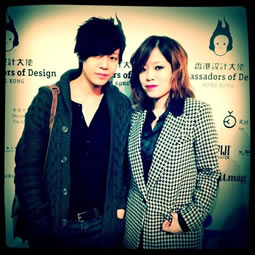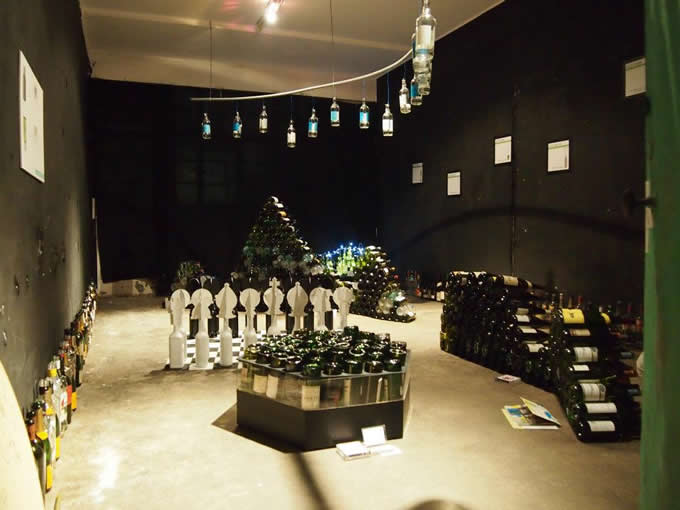 Detour “Use less exhibition” bothered me when a telephone enquiry came in upon glass recycling. I was inspired by Jamie and Yan Choi, two young artists’ commitment in environmental protection. Frankly speaking, I have received a couple enquiries upon free glass pick up for some expired drinks. However, the response is ever negative once the businesses know we can’t cover the labour cost to drain out the liquid nor remove the packages for some thousand bottles, nor can’t offer free ride for not en route. They simply said they would send the glass to landfills for its low cost instead. Dumping glass, in fact, costs us a lot, including occupying the space of landfills, the waste of natural sand (that can be recycled from glass) and the high carbon emission in the course of melting glass wares.
Detour “Use less exhibition” bothered me when a telephone enquiry came in upon glass recycling. I was inspired by Jamie and Yan Choi, two young artists’ commitment in environmental protection. Frankly speaking, I have received a couple enquiries upon free glass pick up for some expired drinks. However, the response is ever negative once the businesses know we can’t cover the labour cost to drain out the liquid nor remove the packages for some thousand bottles, nor can’t offer free ride for not en route. They simply said they would send the glass to landfills for its low cost instead. Dumping glass, in fact, costs us a lot, including occupying the space of landfills, the waste of natural sand (that can be recycled from glass) and the high carbon emission in the course of melting glass wares.
Why Jamie and Yan Choi choose glass for the artwork and how do they look at glass recycling when they paid for hours of packing bottles, absolute physical work for glass delivery and the one thousand dollars for transporting glass to the collection point? We can perhaps find out the hints from the write-up.
April Lai
UNITED MOD is the brainchild of Jamie Yue and Yan Choi that explores creative design in many fields. They recently exhibited at Detour 2011 with their exhibition entitled "Give Glass Life. Glass Gives Life."
Author: Jamie和 Yan Choi
Q. What inspired you to use glass bottles for your installation at Detour 2011?
We were aware of the fact that glass recycling was not popular in Hong Kong and wanted to bring people’s attention to this issue. Wine bottles were chosen in relation to the growing popularity of wine consumption in Hong Kong. They were also chosen for aesthetic reasons and we saw the potential in them to become attractive upcycled goods.
Q. How many bottles did you use? Can you describe the collection process?
In total we used about 700 bottles for the exhibition while in reality we collected almost a 1000 bottles. We spent over a month making numerous trips to various restaurants and bars in Central, Causeway Bay and TST, and got them to help us save used bottles. We made around 3 trips each week to collect anywhere between 30-100 bottles. I think we made more than 20 taxi trips!
Q. What difficulties did you encounter?
It was tough only having two of us girls going down to the restaurants and carrying the bottles ourselves – it was physically tiring! Many restaurants didn’t have a lot of storage space, so we often had to pick them up on short notice. Transportation was also difficult as the bottles were quite heavy but fragile at the same time, so we had to handle them carefully.
Q. What do you think of glass recycling efforts in Hong Kong?
Glass recycling efforts are definitely lacking, and a lot of people are not aware of it at all, throwing glass bottles into the trash can. There also seems to us that Hong Kong lacks glass recycling bins in general, or it hasn’t been publicized enough. We had people come up to us during Detour to ask us where the glass recycling locations were as they had no idea where to throw their bottles.
We think glass collection bins need to be conveniently located and made known to the public, particularly in Hong Kong Island such as the Central district. Many restaurants in Central/CWB throw out hundreds of bottles every week.
Q. How do you think glass can be used in architecture or other ways?
In our exhibition we had an installation of glass bottle walls that alludes to the idea of using glass bottles as a new type of brick, either held with concrete or embedded in it to become a type of reinforcement. Most importantly, as our exhibition has shown, glass should be upcycled in order to cut cost and save energy. This could result in creative products that you incorporate in your everyday life, to cultivate an Upliving style.


